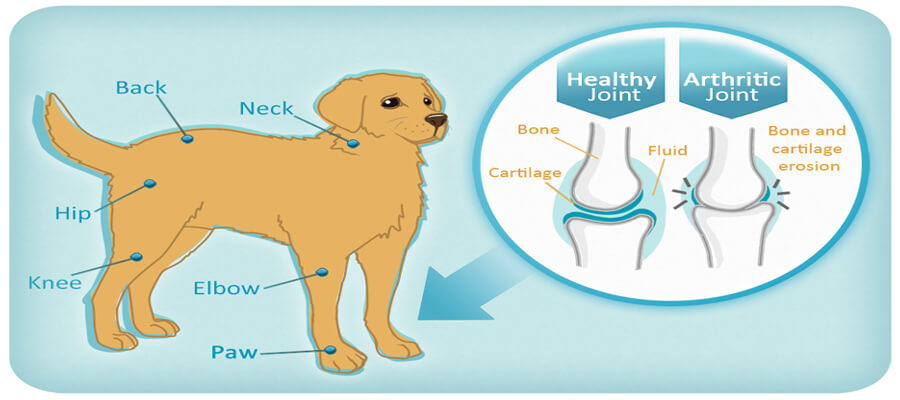
How to Recognize the Early Signs of Arthritis in Dogs
Recognize the Early Signs of Arthritis in Dogs
Introduction
Arthritis is a common condition affecting dogs, particularly as they age. It involves inflammation of the joints, leading to pain and discomfort that can significantly affect a dog’s quality of life. Recognizing the early signs of arthritis is crucial for timely intervention and management. This guide provides dog owners with the knowledge needed to identify potential symptoms and seek appropriate veterinary care.
1. Understanding Arthritis in Dogs
Arthritis in dogs is primarily categorized into two types:
- Osteoarthritis (Degenerative Joint Disease): The most common form, usually resulting from the natural aging process or injury.
- Inflammatory Arthritis: This includes autoimmune diseases like rheumatoid arthritis, which are less common but can cause joint inflammation and pain.
Understanding these types can help owners better recognize the specific symptoms associated with arthritis.
Essentials for Your Newly Adopted Pet
Welcoming a shelter pet into your life is a beautiful journey. Here are some handpicked items to help your new friend feel safe, loved, and right at home:
2. Common Early Signs of Arthritis
Identifying the early signs of arthritis can help dog owners take proactive steps to manage their dog's health. Here are some common symptoms to watch for:
A. Changes in Mobility
- Reluctance to Move: If your dog is hesitant to get up, climb stairs, or jump onto furniture, it may indicate joint pain.
- Stiffness After Rest: Dogs with arthritis often display stiffness after lying down for extended periods, such as when they first get up in the morning.
B. Altered Behavior
- Increased Irritability: Dogs in pain may become more irritable or withdrawn. If your usually friendly dog suddenly seems grumpy or snappy, it could be a sign of discomfort.
- Less Interest in Play: A decrease in enthusiasm for activities they once enjoyed, such as playing fetch or running, can indicate joint issues.
C. Changes in Gait
- Limping or Favoring a Limb: Watch for signs of limping or favoring one leg. This is a clear indication of pain in the joints.
- Shuffling or Hesitant Movement: Dogs may shuffle their feet or move slowly, showing a reluctance to engage in their usual activities.
3. Observing Changes in Daily Routine
Pay attention to changes in your dog’s daily routine, as these can be indicative of arthritis:
A. Changes in Eating and Drinking Habits
- Decreased Appetite: Pain can affect a dog’s desire to eat. If your dog is eating less than usual, consider assessing for joint pain.
- Difficulty Positioning: Dogs may struggle to find comfortable positions to eat or drink, leading to a change in their feeding habits.
B. Changes in Sleeping Patterns
- Restlessness: Dogs in pain may have trouble settling down, resulting in restlessness or frequent changes in sleeping positions.
- Increased Sleep: Conversely, some dogs may sleep more due to pain, as they try to avoid activities that exacerbate their discomfort.
4. Monitoring for Weight Changes
Weight can have a significant impact on a dog’s joint health.
- Weight Gain: Excess weight puts additional strain on joints, worsening arthritis symptoms. Monitor your dog’s weight and consult your vet for dietary advice if you notice an increase.
- Weight Loss: If your dog is losing weight unexpectedly, it could be due to reduced activity levels from joint pain.
5. Seeking Veterinary Care
If you notice any of the early signs of arthritis in your dog, it’s essential to consult your veterinarian for a thorough evaluation.
- Physical Examination: Your vet will conduct a physical examination, checking for signs of pain, swelling, and range of motion in the joints.
- Diagnostic Imaging: X-rays or other imaging techniques may be necessary to assess joint health and determine the extent of any damage.
- Blood Tests: Blood tests can help rule out other conditions and assess overall health.
6. Managing Arthritis in Dogs
If your dog is diagnosed with arthritis, there are various management strategies that can improve their quality of life:
A. Weight Management
- Diet Control: Work with your vet to develop a balanced diet that supports weight loss or maintenance, reducing strain on the joints.
- Regular Exercise: Incorporate low-impact exercises, such as walking or swimming, to maintain mobility without causing further discomfort.
B. Medications
- Pain Relief: Your vet may prescribe non-steroidal anti-inflammatory drugs (NSAIDs) or other pain relief medications to manage discomfort.
- Supplements: Glucosamine and chondroitin supplements can support joint health and improve mobility in some dogs.
C. Alternative Therapies
- Physical Therapy: Professional physical therapy can help improve joint function and reduce pain.
- Acupuncture: Some owners find that acupuncture can provide relief for dogs with arthritis.
7. Conclusion
Recognizing the early signs of arthritis in dogs is crucial for timely intervention and management. By being vigilant and observant, dog owners can detect changes in their pet’s behavior, mobility, and daily routines. Early diagnosis and treatment can lead to a better quality of life for dogs suffering from arthritis, allowing them to enjoy their golden years with comfort and ease. If you suspect your dog may be showing signs of arthritis, consult your veterinarian promptly to discuss appropriate steps for diagnosis and management.
Affiliate Products
We may earn a small commission when you shop through our links — it helps us keep sharing love and care for every dog out there, at no extra cost to you.
Up to 75% Discount

Dog Collar with Health Monitoring
BUY NOW »
Up to 55% Discount

Luxury Faux Furhuge Napping Bed
BUY NOW »

